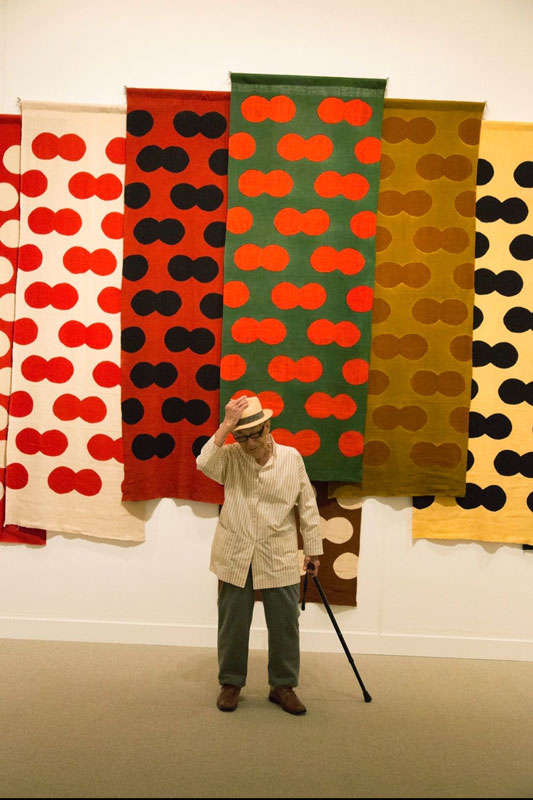
Image: © Norio Kidera. Samiro Yunoki―The Emblem of Life, Setagaya Art Museum, 2 May – 18 August 2013
Workshop: Binding Colours through Textiles: Yunoki Samiro’s Journey in Arts and Crafts
- 1 & 2 July 2024
-
1 July, 13.30 – 17.00,
2 July, 9.30 – 12:00, 13:30 – 17:00 - Online
- https://www.sainsbury-institute.org/events/workshop-binding-colours-through-textiles-yunoki-samiros-journey-in-arts-and-crafts/
- 01603 597507
- sisjac@sainsbury-institute.org
- Tweet
During the postwar period, the Mingei movement endeavoured to cross national boundaries, and its members achieved this by promoting an international outreach of the folk craft ideal, through travelling exhibitions and lectures in various localities. Meanwhile, in Japan, it was a time characterised by the proliferation of handicraft groups whose members were mainly women, employing diverse techniques to create clothes for their family members. It was also a period when local artisans and “Living National Treasures” created their crafts apparently under different premises.
Yunoki Samiro (1922~2024), who joined the Mingei group at the end of the 1940s, earned a position in folk crafts by creating textile pieces that moved from a colourful palette to monochrome compositions during his lifetime. He is known in Japan as a pupil of the Living National Treasure, Serizawa Keisuke (1895~1984). From 1967, Yunoki travelled extensively to places including India, Spain, France, and Greece. These regions inspired him to reach a colour palette beyond Japan and motivated him to question his process as a dye artist. Thereafter, in the 1980s, he departed from Mingei and, for 24 years, explored various printmaking techniques such as monotype, lithography, and even carborundum. Then, in 2007, aged 85, Yunoki began a new series of abstract dye works in a restricted colour palette that he continued until recent years.
During his time as a professor and president of the Joshibi University of Art and Design from 1950 to 1991, one of the women’s universities that from 1900 encouraged “independence of women through art,” he contributed to teaching a significant number of alumni by introducing them to the katazome and chusen dyeing techniques; the former still practised in Japan, whereas the latter is less known.
How has Yunoki’s work and knowledge in the dyeing medium influenced a growing number of women creating textiles? How can we begin to untangle the backdrop of postwar Japan in the diversity of handicraft groups and textile practitioners from this period? In this workshop, we will begin by exploring Mingei’s traits in its transnational contexts, to grasp how Mingei has emerged in other localities outside of Japan. We will then examine the postwar period of textile production in Japan, followed by a discussion on Yunoki’s developments as a dye artist, including his exploration of the printmaking medium and finally cover his most recent creations characterised by large, abstract, and monochrome textile pieces.
Programme
Monday 1 July, 13.30 – 17.00
Panel 1: Transnational Mingei: Exchange and influences from other localities.
Speakers:
Yuko Kikuchi (Senior Tutor, V&A/RCA History of Design Course, Royal College of Art)
Liliana Morais (Rikkyo University)
Roisin Inglesby (Curator William Morris Gallery)
Ana Trujillo Dennis (Universidad Pontificia Comillas)
Eriko Tomizawa-Kay (University of East Anglia)
Tuesday 2 July, 9.30 – 12:00
Panel 2: Textiles in Japan: handicraft groups and diffusion of dyeing techniques.
Speakers:
Toshio Watanabe (Sainsbury Institute)
Tomo Yoshizawa (Writer and Translator)
Ko Shigen (Tokyo Kasei University)
Maria Santamaria Hergueta (International Christian University)
13:30 – 17:00
Panel 3: Yunoki Samiro’s journey in arts and crafts.
Speakers:
Minako Watanabe (Joshibi University of Art and Design)
Rosanna Rios (Sainsbury Institute)
Miles Dodd (Nihon University)
– General discussion –
This hybrid workshop is organised by Dr Rosanna Rios Perez, a Robert and Lisa Sainsbury Fellow. The event is open to public via online participation. Please sign up using the Zoom link below. Note that in-person participation is by invitation only.
